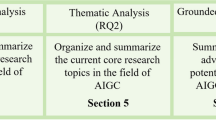Abstract
The human-centred debate in Britain focuses on the idea of human-machine symbiosis, and the “Dialogue” debate in Scandinavia focuses on the deep understanding of human communication, through a process of inner reflection. Both of these debates provide a framework for the participatory design of AI systems.
The emergence of “social Europe” creates the desirability for a sharing of social and cultural knowledge and resources among the citizens of Europe. This raises the possibility of exploiting the potential of new technology for the distribution and transfer of knowledge and skill among the citizens of Europe whilst retaining the diversity of their cultures and languages. These issues of transfer have been the focus of many AI researchers who have been concerned with the design of AI systems for the education, training and welfare of disadvantaged citizens. It is suggested that central to such a transfer is the design of participatory learning systems which focus on the mediation and distribution of knowledge in diverse socio-cultural contexts.
In this paper, the SEAKE Centre's projects, especially “Brighton Parosi”, and “Adult Literacy” are discussed to provide an insight into the concepts and practice of designing such participatory systems. The philosophy of these projects was rooted in the sharing of social and cultural experiences, through participatory learning. The development of the projects involved a process of exchange of language and culture in both formal and informal learning environments. For the Parosi Project social interaction was the central core for the exchange of cultural experiences and the language acquisition process. The Adult Literacy project built on the exchange process, and used the idea of the mediation of knowledge for the design of a knowledge based system. The design process developed by the above two projects could be described as a participatory design approach which builds upon and extends the human-machine symbiosis and dialogue approaches.
Similar content being viewed by others
References
Cooley, M. (1987).Architect or Bee?: The Human Price of Technology, New Extended Edition. The Hogarth Press, London.
Ehn, P. (1988).Work-Oriented Design. Swedish centre For Working Life, Stockholm.
Ennals, R. (1986).Star Wars: a Question of Initiative. John Wiley, Chichester.
Ennals, R. (1987). Socially useful artificial intelligence.AI & Society, 1 (1), 5–16.
The Fast II Programme (1984–87). Summaries of Research projects, European Futures, Commission of the European Communities, rue de la Loi, 200, B-1049, Brussels.
Gill, K. S. (1986a). The knowledge-based machine: issues of knowledge transfer. In Gill, K. S. (ed.) op. cit., 7–17.
Gill, K. S. (ed) (1986b).Artificial Intelligence For Society. John Wiley, Chichester.
Gill, K. S. (1988). Artificial intelligence and social action: education and training. In Goranzon, B. and Josefson, J. (eds.), op. cit., 87–91.
Gill, S. P. (1988). Expert systems: on two AI traditions.AI & Society, 2 (4), 321–340.
Goranzon, B. and Josefson, J. (eds.) (1988).Knowledge, Skill and Artificial Intelligence. Springer-Verlag.
Johannessen, K. (1988). Rule following and tacit knowledge.AI & Society, 2 (4), 287–302.
Jones, S. G. (1985). A knowledge based system for language development for students in continuing education learning English as a second language. MPhil Thesis, Brighton Polytechnic.
Josefson, I. (1988). The nurse as engineer. In Goranzon, B. and Josefson, I. (eds.), op. cit., 19–30.
Negrotti, M. (1987). The piping of thought.AI & Society, 1 (2), 85–92.
Perby, M. (1988). Computerisation and skill in local weather forecasting. In Goranzon, B. and Josefson, I., op. cit., 39–52.
Rauner, R.et al. (1988). The social shaping of technology and work: human-centred systems.AI & Society, 2 (1), 47–62.
Rosenbrock, H. (1988). Engineering as an art.AI & Society, 2 (4), 315–320.
SEAKE Centre/Friends Centre (1985). Final Report on “Basic Education in Numeracy and New Technology”, EEC Social Fund sponsored project, SEAKE Centre, Brighton Polytechnic.
Stamper, R. (1988). Pathologies of AI: responsible use of artificial intelligence in professional work.AI & Society, 2 (4), 3–16.
Whitaker, R. and Ostberg, O. (1988). Channelling knowledge: expert systems as communication media.AI & Society, 2 (3), 197–208.
Author information
Authors and Affiliations
Rights and permissions
About this article
Cite this article
Gill, K.S. Reflections on participatory design. AI & Soc 3, 297–314 (1989). https://doi.org/10.1007/BF01908620
Issue Date:
DOI: https://doi.org/10.1007/BF01908620




